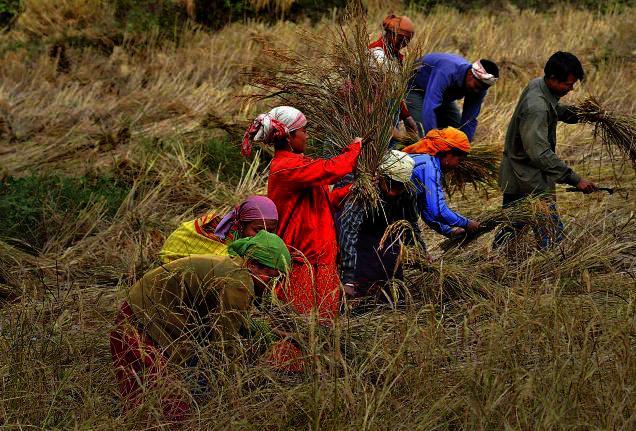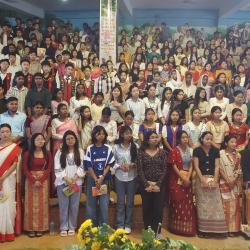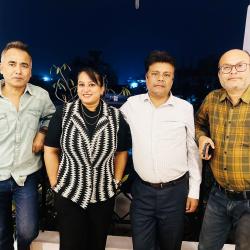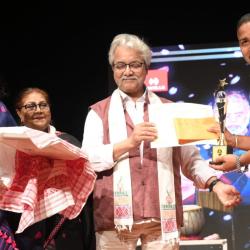Ranjit rice productivity increases by 66 per cent
Ranjit, a high yielding rice variety developed by Assam Agricultural University (AAU) have shown 66 per cent increase in productivity. Technology Showcasing Programme on Seed Production of crops was undertaken recently in five villages of Assam in and around Khetri and Kamrup districts. Hemchandra Saikia, a subject matter specialist in Agricultural Economics revealed that Krishi Vigyan Kendra in Kamrup intervened by providing quality seed of Ranjit along with recommended doses of fertilizers and required technical helps in the form of advices and training to villagers of Deulguri, Chitalpur, Khaloibari, Nuwagaon and Bhadarkuchi and the result was an increase of 65.86 per cent in productivity. The gross return increases by 148.79 per cent over the previous level of productivity and gross return (before the intervention of the Krishi Vigyan Kendra's programme). The concept of the programme of Technology Showcasing Programme on Seed Production of crops was propounded by Dr. K. M. Bujarbaruah, the Vice Chancellor of AAU and under his leadership and guidence the programme was materialised and yielded very encouraging result in other districts of Assam also.
It may be mentioned that the Regional Agricultural Research Station (RARS) of Assam Agricultural University at Titabor has developed a submergence resistent gene in rice variety of Ranjit recently which brings good harvest to flood-hit farmers offering great relief to them. RARS is a research institute of Assam Agriculture University in Jorhat and has been devoting for better scientific cultivation and production for years.
Flood-hit farmers have successfully harvested from the submergence-resistant Suvarna Sub-1(SS-1) variety paddy in 2013. In 2009 for the first time farmers of the state had harvested the water-resistant variety SS-1 in the flood prone areas. The successful experimentation with SS-1 encouraged the Agriculture Department to promote the production of the variety on a wider scale since that year. Scientists, working with drought and water submergence resistant properties, feel those should be instilled in other popular rice varities in India like Sambha masuri, IR-64 etc. The Indian Agricultural Research (ICAR) along with Manila-based International Rice Research Institute (IRRI) is planning to come out with upgraded version of SS-1. The IRRI had released the seed 'Suvarna Sub-1' developed by India in six countries that include Bangladesh, Nepal, Cambodia and Myanmar.
Other Contents by Author
A team of experts from ICIMOD (International Centre for Integrated Mountain Development, Kathmandu, Nepal) have installed flood early warning systems (FEWS) enabled by wireless technology along the Jiadhal and Singara rivers in Assam, India. The installation was carried out under the Himalayan Climate Change Adaptation Programme (HICAP) and is intended to minimize the flood risks and enhance the adaptive capacity of the communities. Before being installed, the FEWS were tested for six months at the ICIMOD Knowledge Park at Godavari in the Kathmandu Valley, Nepal. Two main lessons can be drawn from the Mahakali and Uttarakhand flood disasters: The severity of the disaster could have been...
No doubt, it is one of the most beautiful places in the state of Assam, India. Lampi or Langpih—as the Khasi people calls it—is a hamlet cradled in the hilly terrains of Assam bordering Meghalaya,a neighbouring state. Surrounded by hills where the humming of cascading streams fills the silence, Lampi is yet to witness the boons and banes of a modern life. So pollution, thankfully, is absent. But also absent are the basic amenities like health services, schools, electricity, good cooking fuel, sanitation and nutrition that deprive its residents of the rights which are constitutionally guaranteed to them. With a population of about eleven thousand, mostly Nepalis and Khasis, Lampi falls...
Poisoning rhino horns may be the best measures in Kaziranga National Park (KNP) to check unabated rhino poaching and save the species in the brink of extinction. Since rhino horn or horn-washed water is consumed mostly in China and Southeast Asian countries as medicine and with some superstition. So if horns of live rhinos be poisoned in live rhinos it will be useless. If someone takes or consumes such poisoned horn, that person will be seriously ill rather than any cure or superstitious feeling. Of course, the poisoning must be in such a way which will not harm the rhino itself and when one rhino squeeze other rhinos.The poisoning method has already been applied to save...
It is not the mainland India, but a little happening Golaghat district in Assam in the nooks of the Northeast where the zero (sunya) originated. Ashok Sarma, a language history researcher with the help of Dr H N Dutta, the former Director of Department of Archeology, Government of Assam and Dr Dharmashwar Chutia, a retired professor of Department of Sanskrit, Gauhati University has established that the numerical zero was first discovered and used in written script by a civilization of Assam between 2nd and 3rd century.The uses of zero happened in Assam long before the birth of both Ayarthabhatta and Brahmagupta, Sarma said. The evidence of the practice of using zero in Assam came to light...
If timely measures are not taken the Muga (Antheria assamensis) heritage of Assam may face extinction in the next three decades or within 2040. The production of famous Muga silk of Assam has not been augmented. The state has a demand of more than than 5000 MT of Muga silk anually, but the state has been producing average 90 MT per year. In 2010-11 the state produced113.28 MT Muga and in 2011-12 this amount was 114.56 MT. According to Sericulture Department sources production in the year of 2013 may be same as the average production, not more.The decline of Som and Soalo plantation areas in government sericulture farms have pushed Muga silk towards the verge of extinction, the report said....
The Balipara Reserve Forest, which was once barren and void of trees, now begins to bring back the greens again by dint of a noble effort of some ex-servicemen of Assam. There has been drastic changes spanning four years in Balipara Reserve Forest of Sonitpur district of Assam. In fact, the district happens to be one of the world’s most deforested districts. Enter Eco Task Force (ETF) of the Ecological Territorial Army, a part of the Indian Army envisages plantation drive for aforestation in devastated areas including the one at Sonitpur district of Assam in the Balipara Reserve Forest.The unit has so far planted 2.8 million saplings, covering an area of 2,750 hectares since September...
Fishery and mustard cultivation may be best adaptation measures as livelihood for flood affected people in Assam. Rice cultivation (Hali Kheti) the main livelihood of people has been affected by flood waters and erosion for years and there has been no exception this year. The state is ravaged by flood waters severely and acres of land are covered with sand carried by flood waters. A study carried out by Center for Conservation Education...
A good number of students, researcher and scientists from the northeastern part of the country engaged in different fields, acquired tremendous achievements in foreign countries. Very recently an Assamese scientist working in USA, has shown a new path that can help cure any viral disease like influenza, herpes or HIV. Dr. Ankoor Roy and his colleagues’ achievement has been recognized worldwide by Structure, a prestigious scientific journal.In an interview Dr. Roy said they used P22 bacteriophage as a model system for the research. The researcher and his team have identified small protein which plays a critical role in identifying its own DNA and pumps its own DNA to form a new virus...
Despite large-scale devastation of cropland and paddy fields in the recent waves of flood followed by erosion, the ex-gratia for flood-affected people covers only house and other property. Flood relief usually does not cover agricultural loss and damage in this part of the country. The measures taken by state agriculture department in also not adequate for the flood-hit farmers. Moreover, the state is not brought under natural calamity mitigation programmse because the union government provides facilities to only drought –hit states.
Rainfall is key to Assam’s agricultural production. However, irregular rainfall is taking a toll on the state’s agricultural produce....
As weeks passed, rumors began to brew. Scientists from the world’s most expensive experiment called Large Hadrons Collider of CERN announced what they claim was the discovery of a “missing” particle that adds mass to matter (the Higgs boson, or so-called God particle). But people don’t want to know the detail of the Higgs. Not yet. They want to know why it is important and how this changes human history.Not only me, the first week of the month of July must have been a bit of a roller coaster ride for science community. Now most of people aware that on July 4th scientists of CMS and ATLAS detectors of Large Hadron Collider (LHC) at CERN, Geneva announced the discovery of a new particle. I...








Add new comment